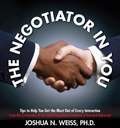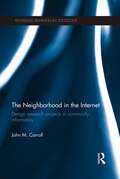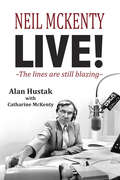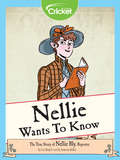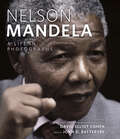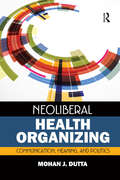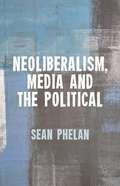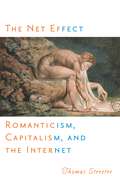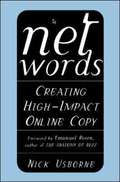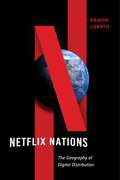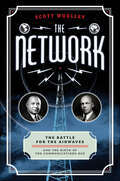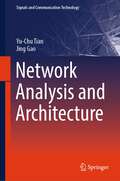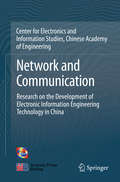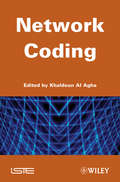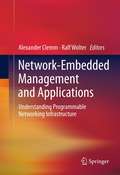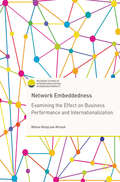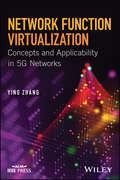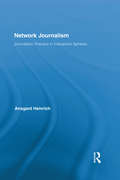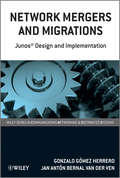- Table View
- List View
Negotiation Techniques (That Really Work!)
by Stephan SchiffmanSales is all about negotiation. Price. Delivery. Terms.And every day, salespeople leave money on the table. They just don't have the skills to get what they want. Now Stephan Schiffman, drawing on years of experience, shows you how to nail the sale, hit quotas, and boost the bottom line. Schiffman-style negotiation is all about getting the best deal. And he outlines specific techniques to get there.Things can be tough out there. But with Schiffman's negotiation skills in your pocket, you can do battle and win.
The Negotiator in You: Negotiation Tips to Help You Get the Most out of Every Interaction at Home, Work, and in Life
by Joshua N. WeissThe Negotiator in You is an introduction to negotiation specifically for people who don't tend to view themselves as negotiators. In this eBook original, Joshua N. Weiss, Ph.D. co-founder of the Global Negotiation Initiative at Harvard University, gives us the tools to enter into a myriad of negotiations with confidence. For workplace negotiations, Weiss coaches us how to effectively negotiate externally with our customers and internally with our boss, colleagues, and subordinates. In a downturned economy, Weiss pays special attention to salary negotiations and finding value among many other factors currently facing everyone in organizations. Beyond the workplace, there are two other critical areas where we negotiate frequently--at home and in life. Turning his eye inward on how we interact at home, Weiss gives us headache-saving tips on how to navigate our way through the holidays and in everyday interactions with our loved ones. And in the negotiations we find ourselves in with the world around us--whether buying a car or house or negotiating with credit card companies--this is essential reading so you don't get taken advantage of. With personalized worksheets for each section you can turn to time and again, the Negotiator in You is the primer you need for smooth sailing at work, home and in life in general.
The Negotiator in You: Sales
by Joshua N. WeissThe Negotiator in You: Sales is for people who sell anything and everything! Salespeople negotiate constantly in today's increasingly competitive marketplace--making negotiation one of the most vital skills. In this book, you will learn to overcome the following key challenges: the tension between short-term gratification (making the sale) and nurturing long-term customers (building the relationship), the problem of negotiating with oneself and how to prevent that from happening, when to take lessons from one negotiation and transfer them and when not to, mapping the players and getting internal alignment before engaging externally, ensuring that an agreement makes sense for you and your company, finding hidden value, dealing with difficult customers--while still making the sale, and using some "crazy wisdom" to engage your customers.
The Neighborhood in the Internet: Design Research Projects in Community Informatics (Routledge Advances in Sociology)
by John M. CarrollToday, "community" seems to be everywhere. At home, at work, and online, the vague but comforting idea of the community pervades every area of life. But have we lost the ability truly to understand what it means? The Neighborhood in the Internet investigates social and civic effects of community networks on local community, and how community network designs are appropriated and extended by community members. Carroll uses his conceptual model of "community" to re-examine the Blacksburg Electronic Village – the first Web-based community network – applying it to attempts to sustain and enrich contemporary communities through information technology. The book provides an analysis of the role of community in contemporary paradigms for work and other activity mediated by the Internet. It brings to the fore a series of design experiments investigating new approaches to community networking and addresses the future trajectory and importance of community networks. This book will be of interest to students of sociology, community psychology, human-computer interaction, information science, and computer-supported collaborative work.
Neil McKenty Live: The lines are still blazing
by Catharine Mckenty Alan HustakNeil McKenty liked to argue just for the hell of it. During the 1970's and 80s he was one of Montreal's highest rated radio talk show hosts. At the peak of his career more than 75,000 people tuned in to CJAD to hear his show, Exchange. 'The basic exchange on Exchange, is not between the listeners and Neil McKenty," he once explained. "It is between the listeners. If the host sets up the chemistry, the show goes on its own momentum, and I am almost on the sidelines. On the other hand, I am in the entertainment business. If I bore my listeners, I'm dead." The material collected in this book focuses on the years he moderated, infuriated, provoked and entertained his listeners.
Nellie Wants to Know: The True Story of Nellie Bly, Reporter
by Liz HuyckDuring an era when women had few freedoms, there was one woman who spoke up for them. She was known as Nellie Bly, a pioneering female investigative reporter of her time. Well known for her record-breaking trip around the globe, her contributions also exposed corruption in a local hospital.
Nelson Mandela: A Life in Photographs
by John D. BattersbyThe New York Times bestselling author celebrates Mandela’s liberation and his fight for freedom with this collection of rare and historic photographs.On February 11th, 1990, Nelson Mandela was finally released from prison after serving twenty-seven years for his struggle against apartheid in South Africa. This beautifully illustrated volume commemorates that event and Mandela’s inspiring life and work.Created by renowned author David Elliot Cohen—who has worked with many of the top photojournalists who chronicled the “apartheid battles”—Nelson Mandela contains many images that have rarely, if ever, been seen, as well as the iconic photos that came to define this chapter in history. This volume also includes the full text of Mandela’s six most important speeches, an essay on his historic significance, and a detailed overview of the struggle against apartheid.
Neoliberal Health Organizing: Communication, Meaning, and Politics (Critical Cultural Studies in Global Health Communication #2)
by Mohan J DuttaMohan J Dutta closely interrogates the communicative forms and practices that have been central to the establishment of neoliberal governance. In particular, he examines cultural discourses of health in relationship to the market and the health implications of these cultural discourses. Using examples from around the world, he explores the roles of public-private partnerships, NGOs, militaries, and new technologies in reinforcing the link between market and health. Identifying the taken-for-granted assumptions that constitute the foundations of global neoliberal organizing, he offers an alternative strategy for a grassroots-driven participatory form of global organizing of health. This inventive theoretical volume speaks to those in critical communication, in health research, in social policy, and in contemporary political economy studies.
Neoliberalism, Media and the Political
by Sean PhelanNeoliberalism, Media and the Political examines the condition of media and journalism in neoliberal cultures. Emphasizing neoliberalism's status as a political ideology that is simultaneously hostile to politics, the book presents a critical theoretical argument supported by empirical illustrations from New Zealand, Ireland, the UK and the US.
The Net Effect: Romanticism, Capitalism, and the Internet (Critical Cultural Communication #32)
by Thomas StreeterThis book about America's romance with computer communication looks at the internet, not as harbinger of the future or the next big thing, but as an expression of the times. Streeter demonstrates that our ideas about what connected computers are for have been in constant flux since their invention. In the 1950s they were imagined as the means for fighting nuclear wars, in the 1960s as systems for bringing mathematical certainty to the messy complexity of social life, in the 1970s as countercultural playgrounds, in the 1980s as an icon for what's good about free markets, in the 1990s as a new frontier to be conquered and, by the late 1990s, as the transcendence of markets in an anarchist open source utopia.The Net Effect teases out how culture has influenced the construction of the internet and how the structure of the internet has played a role in cultures of social and political thought. It argues that the internet's real and imagined anarchic qualities are not a product of the technology alone, but of the historical peculiarities of how it emerged and was embraced. Finding several different traditions at work in the development of the internet--most uniquely, romanticism--Streeter demonstrates how the creation of technology is shot through with profoundly cultural forces--with the deep weight of the remembered past, and the pressures of shared passions made articulate.
Net Words: Creating High-Impact Online Copy
by Nick UsborneA practical guide on how to write online text that is funny, personal, engaging, and informative-in short, how to write text that people actually want to read. It gives insight on how to attract customers by online communication.
Netflix Nations: The Geography of Digital Distribution (Critical Cultural Communication #28)
by Ramon LobatoHow streaming services and internet distribution have transformed global television culture. Television, once a broadcast medium, now also travels through our telephone lines, fiber optic cables, and wireless networks. It is delivered to viewers via apps, screens large and small, and media players of all kinds. In this unfamiliar environment, new global giants of television distribution are emerging—including Netflix, the world’s largest subscription video-on-demand service. Combining media industry analysis with cultural theory, Ramon Lobato explores the political and policy tensions at the heart of the digital distribution revolution, tracing their longer history through our evolving understanding of media globalization. Netflix Nations considers the ways that subscription video-on-demand services, but most of all Netflix, have irrevocably changed the circulation of media content. It tells the story of how a global video portal interacts with national audiences, markets, and institutions, and what this means for how we understand global media in the internet age. Netflix Nations addresses a fundamental tension in the digital media landscape – the clash between the internet’s capacity for global distribution and the territorial nature of media trade, taste, and regulation. The book also explores the failures and frictions of video-on-demand as experienced by audiences. The actual experience of using video platforms is full of subtle reminders of market boundaries and exclusions: platforms are geo-blocked for out-of-region users (“this video is not available in your region”); catalogs shrink and expand from country to country; prices appear in different currencies; and subtitles and captions are not available in local languages. These conditions offer rich insight for understanding the actual geographies of digital media distribution. Contrary to popular belief, the story of Netflix is not just an American one. From Argentina to Australia, Netflix’s ascension from a Silicon Valley start-up to an international television service has transformed media consumption on a global scale. Netflix Nations will help readers make sense of a complex, ever-shifting streaming media environment.
Netflixed
by Gina KeatingNetflix has come a long way since 1997, when two Silicon Valley entrepreneurs, Marc Randolph and Reed Hastings, decided to start an online DVD store before most people owned a DVD player. They were surprised and elated when launch-day traffic in April 1998 crashed their server and resulted in 150 sales. Today, Netflix has more than 25 million subscribers and annual revenues above $3 billion. Yet long- term success-or even survival-is still far from guaranteed. Journalist Gina Keating recounts the absorbing, fast-paced drama of the company's turbulent rise to the top and its attempt to invent two new kinds of business. First it engaged in a grueling war against video-store behemoth Blockbuster, transforming movie rental forever. Then it jumped into an even bigger battle for online video streaming against Google, Hulu, Amazon, and the big cable companies. Netflix ushered in such innovations as DVD rental by mail, a patented online queue of upcoming rentals, and a recommendation algorithm called Cinematch that proved crucial in its struggle against bigger rivals. Yet for all its success, Netflix is still a polarizing company. Hastings is often heralded as a visionary-he was named Business Person of the Year in 2010 by Fortune-even as he has been called the nation's worst CEO. Netflix also faces disgruntled customers after price increases and other stumbles that could tarnish the brand forever. The quest to become the world's portal for premium video on demand will determine nothing less than the future of entertainment and the Internet. Drawing on extensive new interviews and her years covering Netflix as a financial and entertainment reporter, Keating makes this tale as absorbing as it is important.
Netflixed: The Epic Battle for America's Eyeballs
by Gina KeatingNetflix has come a long way since 1997, when two Silicon Valley entrepreneurs, Marc Randolph and Reed Hastings, decided to start an online DVD store before most people owned a DVD player. They were surprised and elated when launch-day traffic in April 1998 crashed their server and resulted in 150 sales. Today, Netflix has more than 25 million subscribers and annual revenues above $3 billion. Yet long- term success-or even survival-is still far from guaranteed. Journalist Gina Keating recounts the absorbing, fast-paced drama of the company's turbulent rise to the top and its attempt to invent two new kinds of business. First it engaged in a grueling war against video-store behemoth Blockbuster, transforming movie rental forever. Then it jumped into an even bigger battle for online video streaming against Google, Hulu, Amazon, and the big cable companies. Netflix ushered in such innovations as DVD rental by mail, a patented online queue of upcoming rentals, and a recommendation algorithm called Cinematch that proved crucial in its struggle against bigger rivals. Yet for all its success, Netflix is still a polarizing company. Hastings is often heralded as a visionary-he was named Business Person of the Year in 2010 by Fortune-even as he has been called the nation's worst CEO. Netflix also faces disgruntled customers after price increases and other stumbles that could tarnish the brand forever. The quest to become the world's portal for premium video on demand will determine nothing less than the future of entertainment and the Internet. Drawing on extensive new interviews and her years covering Netflix as a financial and entertainment reporter, Keating makes this tale as absorbing as it is important.
Netflixed
by Gina KeatingThe history of Netflix is a long struggle for greatness marked by multiple disasters, lucky breaks, personal betrayal, and broken hearts. It has more drama than most of the movies Netflix rents. Netflix has come a long way since 1997, when two Silicon Valley entrepreneurs, Marc Randolph and Reed Hastings, decided to start an online DVD store before most people owned a DVD player. They were surprised and elated when launch-day traffic in April 1998 crashed their server and resulted in 150 sales. Today, Netflix has more than 25 million subscribers and annual revenues above $3 billion. Yet long- term success—or even survival—is still far from guaranteed. Journalist Gina Keating recounts the absorbing, fast-paced drama of the company’s turbulent rise to the top and its attempt to invent two new kinds of business. First it engaged in a grueling war against video-store behemoth Blockbuster, transforming movie rental forever. Then it jumped into an even bigger battle for online video streaming against Google, Hulu, Amazon, and the big cable companies. Netflix ushered in such innovations as DVD rental by mail, a patented online queue of upcoming rentals, and a recommendation algorithm called Cinematch that proved crucial in its struggle against bigger rivals. Yet for all its success, Netflix is still a polarizing company. Hastings is often heralded as a visionary—he was named Business Person of the Year in 2010 by Fortune—even as he has been called the nation’s worst CEO. Netflix also faces disgruntled customers after price increases and other stumbles that could tarnish the brand forever. The quest to become the world’s portal for premium video on demand will determine nothing less than the future of entertainment and the Internet. Drawing on extensive new interviews and her years covering Netflix as a financial and entertainment reporter, Keating makes this tale as absorbing as it is important. .
The Network: The Battle for the Airwaves and the Birth of the Communications Age
by Scott WoolleyThe astonishing story of America’s airwaves, the two friends—one a media mogul, the other a famous inventor—who made them available to us, and the government which figured out how to put a price on air.This is the origin story of the airwaves—the foundational technology of the communications age—as told through the forty-year friendship of an entrepreneurial industrialist and a brilliant inventor.David Sarnoff, the head of RCA and equal parts Steve Jobs, Jack Welch, and William Randolph Hearst, was the greatest supporter of his friend Edwin Armstrong, developer of the first amplifier, the modern radio transmitter, and FM radio. Sarnoff was convinced that Armstrong’s inventions had the power to change the way societies communicated with each other forever. He would become a visionary captain of the media industry, even predicting the advent of the Internet.In the mid-1930s, however, when Armstrong suspected Sarnoff of orchestrating a cadre of government officials to seize control of the FM airwaves, he committed suicide. Sarnoff had a very different view of who his friend’s enemies were.Many corrupt politicians and corporations saw in Armstrong’s inventions the opportunity to commodify our most ubiquitous natural resource—the air. This early alliance between high tech and business set the precedent for countless legal and industrial battles over broadband and licensing bandwidth, many of which continue to influence policy and debate today.
Network Analysis and Architecture (Signals and Communication Technology)
by Yu-Chu Tian Jing GaoThis book covers network analysis and architecture for large-scale computer network planning. Networks and the Internet are essential for modern industries and societies. Building a new network, upgrading an existing network, or planning to use a public network requires integrating various network mechanisms and technologies in a cohesive fashion. This demands a deep understanding of the concepts, principles, processes, approaches, and good practices of advanced network planning. More specifically, emphasizing service-based networking, the book introduces structured processes for network planning, provides systematic approaches for network analysis and architecture, develops network planning specifications, and discusses high-level network architectural models from various perspectives. It also offers detailed discussions on component-based architecture about addressing, routing, performance, management, and security and privacy. Recent developments in data centers, virtualization, and cloud are also embedded into the network architecture. Moreover, the book includes a comprehensive introduction to building practical TCP/IP network communications via sockets with practical examples. The book is suitable for use as a textbook for senior undergraduate and postgraduate students or as a reference book for network practitioners looking to develop or enhance their skills in network planning.
Network and Communication: Research on the Development of Electronic Information Engineering Technology in China
by Chinese Academy of EngineeringCurrently, there are global endeavors to integrate network information into the natural world and human society. This process will lead to marked improvements in productivity and product quality, and to new production methods and lifestyles. Further, these advances will have significant impacts, similar to those of the agricultural and industrial revolutions. At the same time, it is profoundly changing competition around the globe. Security, economic, social, military and cultural trends generate new opportunities for national development, new living spaces for humans, new fields of social governance, and new momentum for industrial upgrading and international competition. Over the next 20 years, the development of network communication technologies will focus on three-domain human-network-thing interconnections and their systematic integration into various industries and regions. This will be made possible by digitalization, networking and intellectualization, and will result in the extended connection of human societies around the globe, and a continuously enriched and expanded network space.This book summarizes the development of network communication, both globally and in China, as well as its future prospects from the perspectives of academia, technology and industry. Further, in the context of technology and applications, it focuses on mobile communication, data communication, and optical fiber communication. Discussing application services related to the mobile Internet, Internet of Things, edge computing and quantum communication, it highlights the latest technological advances, future trends, technologies and industry development hotspots. Lastly, it explores 15 buzzwords in the field of network communication in technology and industrial development, providing definitions, and describing the state of development of related applications.
Network-Based Control of Unmanned Marine Vehicles
by Yu-Long Wang Qing-Long Han Chen Peng Lang MaThis book presents a comprehensive analysis of stability, stabilization, and fault detection in networked control systems, with a focus on unmanned marine vehicles. It investigates the challenges of network-based control in areas like heading control, fault detection filter and controller design, dynamic positioning, and cooperative target tracking. Communication networks in control systems can induce delays and dropouts, so the book presents the importance of stability analysis, stabilize, and fault detection. To help readers gain a deeper understanding of these concepts, the book provides fundamental concepts and real-world examples. This book is a valuable resource for researchers and practitioners working in the field of network-based control for unmanned marine vehicles.
Network Coding
by Khaldoun Al AghaNetwork coding, a relatively new area of research, has evolved from the theoretical level to become a tool used to optimize the performance of communication networks – wired, cellular, ad hoc, etc. The idea consists of mixing “packets” of data together when routing them from source to destination. Since network coding increases the network performance, it becomes a tool to enhance the existing protocols and algorithms in a network or for applications such as peer-to-peer and TCP. This book delivers an understanding of network coding and provides a set of studies showing the improvements in security, capacity and performance of fixed and mobile networks. This is increasingly topical as industry is increasingly becoming more reliant upon and applying network coding in multiple applications. Many cases where network coding is used in routing, physical layer, security, flooding, error correction, optimization and relaying are given – all of which are key areas of interest. Network Coding is the ideal resource for university students studying coding, and researchers and practitioners in sectors of all industries where digital communication and its application needs to be correctly understood and implemented. Contents 1. Network Coding: From Theory to Practice, Youghourta Benfattoum, Steven Martin and Khaldoun Al Agha. 2. Fountain Codes and Network Coding for WSNs, Anya Apavatjrut, Claire Goursaud, Katia Jaffrès-Runser and Jean-Marie Gorce. 3. Switched Code for Ad Hoc Networks: Optimizing the Diffusion by Using Network Coding, Nour Kadi and Khaldoun Al Agha. 4. Security by Network Coding, Katia Jaffrès-Runser and Cédric Lauradoux. 5. Security for Network Coding, Marine Minier, Yuanyuan Zhang and Wassim Znaïdi. 6. Random Network Coding and Matroids, Maximilien Gadouleau. 7. Joint Network-Channel Coding for the Semi-Orthogonal MARC: Theoretical Bounds and Practical Design, Atoosa Hatefi, Antoine O. Berthet and Raphael Visoz. 8. Robust Network Coding, Lana Iwaza, Marco Di Renzo and Michel Kieffer. 9. Flow Models and Optimization for Network Coding, Eric Gourdin and Jeremiah Edwards.
Network-Embedded Management and Applications
by Ralf Wolter Alexander ClemmDespite the explosion of networking services and applications in the past decades, the basic technological underpinnings of the Internet have remained largely unchanged. At its heart are special-purpose appliances that connect us to the digital world, commonly known as switches and routers. Now, however, the traditional framework is being increasingly challenged by new methods that are jostling for a position in the "next-generation" Internet. The concept of a network that is becoming more programmable is one of the aspects that are taking center stage. This opens new possibilities to embed software applications inside the network itself and to manage networks and communications services with unprecedented ease and efficiency. In this edited volume, distinguished experts take the reader on a tour of different facets of programmable network infrastructure and applications that exploit it. Presenting the state of the art in network embedded management and applications and programmable network infrastructure, the book conveys fundamental concepts and provides a glimpse into various facets of the latest technology in the field.
Network Embeddedness
by Milena Ratajczak-MrozekThis book systematizes the concepts of business relationships and network embeddedness, taking a new approach to internationalization, relevant for the global economy. It reflects the growing importance of network internationalization theory and explores the impact of embeddedness in domestic and foreign relationships on a company's performance. The author questions the validity of the distinction between domestic and foreign activity of companies and demonstrates that in the B2B market, there are actually no exclusively domestic companies which are not directly or indirectly connected with foreign entities. Chapters cover both small to medium sized enterprises and large multinational corporations, presenting a qualitative analysis of over 400 companies including case studies from the IT and furniture industries. This informative study will provide useful insight for academics and students of business and management, international business and organization studies.
Network Function Virtualization: Concepts And Applicability In 5g Networks (Wiley - Ieee Ser.)
by Ying ZhangA horizontal view of newly emerged technologies in the field of network function virtualization (NFV), introducing the open source implementation efforts that bring NFV from design to reality This book explores the newly emerged technique of network function virtualization (NFV) through use cases, architecture, and challenges, as well as standardization and open source implementations. It is the first systematic source of information about cloud technologies' usage in the cellular network, covering the interplay of different technologies, the discussion of different design choices, and its impact on our future cellular network. Network Function Virtualization: Concepts and Applicability in 5G Networks reviews new technologies that enable NFV, such as Software Defined Networks (SDN), network virtualization, and cloud computing. It also provides an in-depth investigation of the most advanced open source initiatives in this area, including OPNFV, Openstack, and Opendaylight. Finally, this book goes beyond literature review and industry survey by describing advanced research topics such as service chaining, VNF orchestrations, and network verification of NFV systems. In addition, this resource: Introduces network function virtualization (NFV) from both industrial and academic perspectives Describes NFV's usage in mobile core networks, which is the essence of 5G implementation Offers readers a deep dive on NFV's enabling techniques such as SDN, virtualization, and cloud computing Network Function Virtualization: Concepts and Applicability in 5G Networks is an ideal book for researchers and university students who want to keep up with the ever-changing world of network function virtualization.
Network Journalism: Journalistic Practice in Interactive Spheres (Routledge Research in Journalism)
by Ansgard HeinrichDrawing on current theoretical debates in journalism studies, and grounded in empirical research, Heinrich here analyzes the interplay between journalistic practice and processes of globalization and digitalization. She argues that a new kind of journalism is emerging, characterized by an increasingly global flow of news as well as a growing number of news deliverers. Within this transformed news sphere the roles of journalistic outlets change. They become nodes, arranged in a dense net of information gatherers, producers, and disseminators. The interactive connections among these news providers constitute what Heinrich calls the sphere of "network journalism."
Network Mergers and Migrations
by Jan Ant?n Bernal van der Ven Gonzalo G?mez HerreroThis book provides you with guidelines to plan, design, roll out, and accomplish network migration activities with a variety of internetworking case studies. It considers both enterprise and service provider scenarios based on the expertise from Juniper Networks engineers. From Metro Ethernet migration approaches to comprehensive network protocol consolidation and integration, each case study covers JUNOS resources to ensure successful completion at each migration phase. In addition to an appendix of automation scripts and examples and guidelines for each step, the book also describes the modern challenges that evolve in IT networks.

